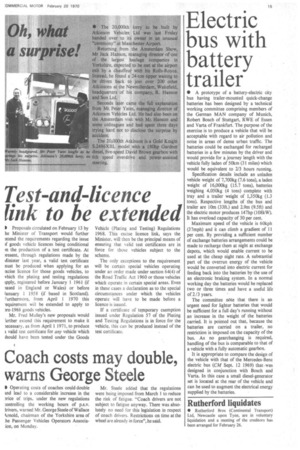Electric bus with battery railer
Page 17

If you've noticed an error in this article please click here to report it so we can fix it.
• A prototype of a battery-electric city bus having trailer-mounted quick-change batteries has been designed by a technical working committee comprising members of the German MAN company of Munich, Robert Bosch of Stuttgart, RWE of Essen and Varta of Frankfurt. The purpose of the exercise is to produce a vehicle that will be acceptable with regard to air pollution and noise in areas of dense urban traffic. The batteries could be exchanged for recharged batteries in a few minutes by the driver and would provide for a journey length with the vehicle fully laden of 50km (31 miles) which would be equivalent to 2/3 hours running.
Specification details include an unladen vehicle weight of 7,700kg (7.6 tons), a laden weight of 16,000kg (15.7 tons), batteries weighing 4,050kg (4 tons) complete with tray and a trailer weight of 1,350kg (1.3 tons). Respective lengths of the bus and trailer are 10m (33ft.) and 2.9m (9.5ft) and the electric motor produces 147hp (108kW). It has overload capacity of 30 per cent.
Maximum speed of the vehicle is 60kph (37mph) and it can climb a gradient of 11 per cent. By providing a sufficient number of exchange batteries arrangements could be made to recharge them at night at exchange depots, which would enable current to be used at the cheap night rate. A substantial part of the overrun energy of the vehicle would be converted into electric current for feeding back into the batteries by the use of an electronic braking system. In a normal working day the batteries would be replaced two or three times and have a useful life of 2/3 years.
The committee nOte that there is an urgent need for lighter batteries that would be sufficient for a full day's running without an increase in the weight of the batteries carried. It is pointed out that, because the batteries are carried on a trailer, no restriction is imposed on the capacity of the bus. As no gearchanging is required, handling of the bus is comparable to that of a vehicle with a fully automatic gearbox.
It is appropriate to compare the design of the vehicle with that of the Mercedes-Benz electric bus (CM Sept. 12 1969) that was designed in conjunction with Bosch and Varta. In this case a small diesel-generator set is located at the rear of the vehicle and can be used to augment the electrical energy supplied by the batteries.
Rutherford liquidates
• Rutherford Bros (Continental Transport) Ltd, Newcastle upon Tyne, are in voluntary liquidation and a meeting of the creditors has been arranged for February 26.














































































































































































































